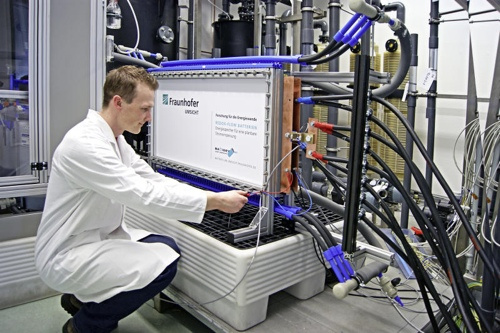Hokkaido Electric plans to invest $200 million into a 60,000 kWh, vanadium redox flow battery that will store energy in order to back up its electricity grid.

A previous vanadium redox flow battery prototype.
Image Credit: © Fraunhofer UMSICHT
“A redox battery is an electrochemical system that generates oxidation and reduction between two active materials, forming a redox system, on the surface of inactive electrodes (the electrodes themselves do not change),” according to Green Car Congress.
This battery is expected to last 20 years and cost $3,333 per kWh, which is substantially higher than today’s commercial lithium-ion battery banks, which have shorter lifespans (10 years in the case of lithium-iron phosphate).
But the lithium-ion energy storage industry is fairly established, while the vanadium redox battery industry is in its infancy. Could the cost of vanadium redox batteries decrease if their production scale grows? Possibly.
Almost all technologies start out very expensive, and their prices came down due to economies of scale and technological advancements. The 20-year lifespan should also be factored in. That hedges against electricity and technology cost increases in the coming years.
Economies of scale causes production cost reductions because purchasing the materials and parts required to build batteries in larger quantities is incentivized with quantity discounts. A larger quantity = a lower cost per part, or per pound of the material (generally).
Lithium-ion batteries are actually a good example of this. The smallest lithium-ion batteries on the market are the most expensive. Li-ion cellphone batteries, for example, tend to cost $3 per Wh (the equivalent of $3,000 per kWh), while on a large scale, lithium-ion batteries can cost as little as $400 per kWh.
[source: http://feeds.importantmedia.org/~r/IM-greenbuildingelements/~3/uJUmzQJBh9o/]

Leave a Reply
You must be logged in to post a comment.